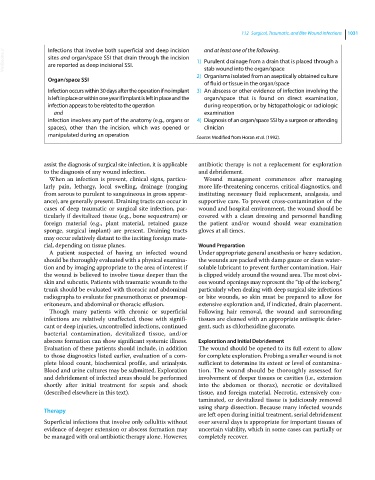Page 1093 - Clinical Small Animal Internal Medicine
P. 1093
112 Surgical, Traumatic, and Bite Wound Infections 1031
and at least one of the following.
VetBooks.ir Infections that involve both superficial and deep incision 1) Purulent drainage from a drain that is placed through a
sites and organ/space SSI that drain through the incision
are reported as deep incisional SSI.
stab wound into the organ/space
2) Organisms isolated from an aseptically obtained culture
Organ/space SSI
of fluid or tissue in the organ/space
Infection occurs within 30 days after the operation if no implant 3) An abscess or other evidence of infection involving the
is left in place or within one year if implant is left in place and the organ/space that is found on direct examination,
infection appears to be related to the operation during reoperation, or by histopathologic or radiologic
and examination
infection involves any part of the anatomy (e.g., organs or 4) Diagnosis of an organ/space SSI by a surgeon or attending
spaces), other than the incision, which was opened or clinician
manipulated during an operation Source: Modified from Horan et al. (1992).
assist the diagnosis of surgical site infection, it is applicable antibiotic therapy is not a replacement for exploration
to the diagnosis of any wound infection. and debridement.
When an infection is present, clinical signs, particu- Wound management commences after managing
larly pain, lethargy, local swelling, drainage (ranging more life‐threatening concerns, critical diagnostics, and
from serous to purulent to sanguineous in gross appear- instituting necessary fluid replacement, analgesia, and
ance), are generally present. Draining tracts can occur in supportive care. To prevent cross‐contamination of the
cases of deep traumatic or surgical site infection, par- wound and hospital environment, the wound should be
ticularly if devitalized tissue (e.g., bone sequestrum) or covered with a clean dressing and personnel handling
foreign material (e.g., plant material, retained gauze the patient and/or wound should wear examination
sponge, surgical implant) are present. Draining tracts gloves at all times.
may occur relatively distant to the inciting foreign mate-
rial, depending on tissue planes. Wound Preparation
A patient suspected of having an infected wound Under appropriate general anesthesia or heavy sedation,
should be thoroughly evaluated with a physical examina- the wounds are packed with damp gauze or clean water‐
tion and by imaging appropriate to the area of interest if soluble lubricant to prevent further contamination. Hair
the wound is believed to involve tissue deeper than the is clipped widely around the wound area. The most obvi-
skin and subcutis. Patients with traumatic wounds to the ous wound openings may represent the “tip of the iceberg,”
trunk should be evaluated with thoracic and abdominal particularly when dealing with deep surgical site infections
radiographs to evaluate for pneumothorax or pneumop- or bite wounds, so skin must be prepared to allow for
eritoneum, and abdominal or thoracic effusion. extensive exploration and, if indicated, drain placement.
Though many patients with chronic or superficial Following hair removal, the wound and surrounding
infections are relatively unaffected, those with signifi- tissues are cleaned with an appropriate antiseptic deter-
cant or deep injuries, uncontrolled infections, continued gent, such as chlorhexidine gluconate.
bacterial contamination, devitalized tissue, and/or
abscess formation can show significant systemic illness. Exploration and Initial Debridement
Evaluation of these patients should include, in addition The wound should be opened to its full extent to allow
to those diagnostics listed earlier, evaluation of a com- for complete exploration. Probing a smaller wound is not
plete blood count, biochemical profile, and urinalysis. sufficient to determine its extent or level of contamina-
Blood and urine cultures may be submitted. Exploration tion. The wound should be thoroughly assessed for
and debridement of infected areas should be performed involvement of deeper tissues or cavities (i.e., extension
shortly after initial treatment for sepsis and shock into the abdomen or thorax), necrotic or devitalized
(described elsewhere in this text). tissue, and foreign material. Necrotic, extensively con-
taminated, or devitalized tissue is judiciously removed
using sharp dissection. Because many infected wounds
Therapy
are left open during initial treatment, serial debridement
Superficial infections that involve only cellulitis without over several days is appropriate for important tissues of
evidence of deeper extension or abscess formation may uncertain viability, which in some cases can partially or
be managed with oral antibiotic therapy alone. However, completely recover.

